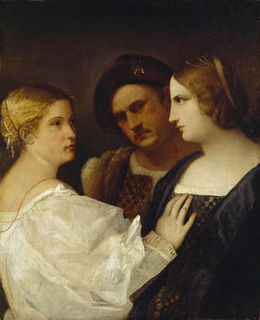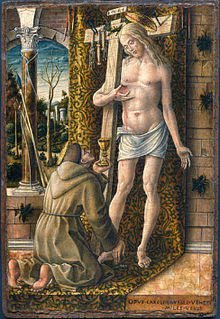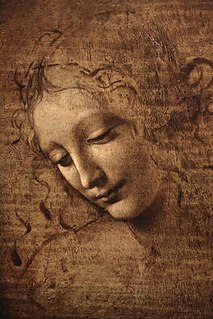 W
WThe Adoration of the Kings is an oil painting on panel of c. 1500 by Bramantino in the National Gallery, London. In it the Holy Family and the Magi are, unusually, joined by an adult John the Baptist, whose Baptism of Christ was celebrated on the same day as Epiphany in the liturgical calendar. The panel entered the National Gallery in 1916 as part of the Layard Bequest.
 W
WAllegory of Fertility and Abundance is a c.1500 allegorical tempera on panel painting by Luca Signorelli, now in the Uffizi in Florence. Produced around the same time as the artist's frescoes in the San Brizio Chapel in Orvieto, the work was a monochrome allegory inspired by classical bas-reliefs and intended for a humanist scholar's studiolo. Its figures refer to the artist's nudes in his frescoes at Orvieto and Madonna and Child with Ignudi.
 W
WThe Annunciation is a c.1500 two-part oil on canvas painting by Giovanni Bellini and his studio assistants. Each of the two canvases measures 224 by 105 cm and they are both now in the Gallerie dell'Accademia in Venice. They were produced to be the external doors or covers to the organ at Santa Maria dei Miracoli, Venice – on their reverses were St Peter and St Paul (lost).
 W
WChrist Blessing is a painting by Italian Renaissance master Giovanni Bellini created around the year 1500.
 W
WChrist Crowned with Thorns is a c.1500 oil on panel painting by Albrecht Bouts, now in the Musée des Beaux-Arts de Lyon, which acquired it in 2011.
 W
WDetroit Trio is an oil on canvas painting attributed to Giorgione, Titian and Sebastiano del Piombo, executed c. 1500, now in the Detroit Institute of Arts. The letters ACH on the man's beret are variously interpreted as "Amor, Concordia e Honor" or "Amor, Charitas e Humanitas", whilst others argue the figures show Jason between Medea and Creusa.
 W
WExemplary Women of Antiquity is a set of paintings produced between 1495 and 1500 by Andrea Mantegna. They show the Carthaginian noblewoman Sophonisba poisoning herself to avoid being paraded in a Roman triumph, the Roman Vestal Virgin Tuccia proving her chastity by carrying water in a sieve, Judith with the head of Holofernes and Dido holding Sychaeus's funeral urn. Infrared reflectography has uncovered a signature on the back of Judith reading And.a Mantegnia. P[inxit].. Sophonisba and Tuccia are egg-tempera on poplar panel, whilst Judith and Holofernes are glue-tempera on linen canvas.
 W
WHercules Killing the Stymphalian Birds is a 1500 tempera on canvas painting by Albrecht Dürer, now collectedin the Germanisches Nationalmuseum in Nuremberg.
 W
WThe Holy Family with a Female Saint is a 1495–1505 tempera on canvas painting attributed to Andrea Mantegna - the lose of the original finish and re-painting means that the painting itself cannot be securely attributed to him, though the silverpoint under-drawing is definitely in the master's hand. To the left is saint Joseph and to the right is an unidentified female saint, possibly Mary Magdalene.
 W
WThe Holy Family with Christ as Imperator mundi is a 71 by 50.5 cm tempera on canvas painting dated to around 1490-1500. It is attributed to Andrea Mantegna and now held in the Petit Palais in Paris.
 W
WThe Holy Family with Saints Anne and John the Baptist is a tempera on canvas painting by Andrea Mantegna, dating to 1495-1500. It measures 75.5 cm by 61.5 cm and is now in the Gemäldegalerie in Dresden.
 W
WThe Holy Family with the Infant Saint John the Baptist is a tempera on canvas painting measuring 71 cm by 50.5 cm. It is attributed to Andrea Mantegna, dated to around 1500 and now held in the National Gallery, London. Its poor conservation means that some scholars do not directly attribute it to Mantegna, though its idea and format definitely refer to autograph works by him.
 W
WLamentation of Christ is an oil-on-panel painting of the common subject of the Lamentation of Christ by the German Renaissance artist Albrecht Dürer, executed around 1500 and now in the Alte Pinakothek of Munich, Germany.
 W
WLamentation over the Dead Christ is a c.1500 tempera on panel painting by Giovanni Bellini. It is in chiaroscuro and may have been intended as a studio exemplar for his pupils or the uncompleted underdrawing of a full painting. It was given to Ferdinand III, Grand Duke of Tuscany by doge Alvise Giovanni Mocenigo in return for a gold, diamond and pietra dura snuffbox. The Grand Duke later gave it to the Uffizi Gallery on 22 October 1798; it is still in its collection.
 W
WMadonna and Child is a magra-tempera on flax canvas painting by Andrea Mantegna, dating to 1490-1500 or 1463-1465 . It is now in the Accademia Carrara in Bergamo. It dates to after the painter's trip to Rome and belongs to a group of small-format Madonnas for private devotion - others include Madonna with Sleeping Child (Berlin), the Poldi Pezzoli Madonna and the Butler Madonna. The Bergamo work is unique among them in that it has a happy rather than melancholic atmosphere. The Christ Child wears a coral bracelet, formerly an apotropaic symbol and also a foreshadowing of his Passion.
 W
WThe Madonna and Child with Saints is a tempera on panel painting, attributed to Andrea Mantegna, dated to around 1500 and now in the Galleria Sabauda in Turin. Its top left hand corner is badly damaged.
 W
WThe Madonna and Child with Three Saints is a 1490-1500 tempera on canvas painting attributed to Andrea Mantegna, now in the Musée Jacquemart-André in Paris. Heavily damaged, not all art historians attribute it as an autograph work. If it is, it belongs to a group of small-format Madonnas for private devotions, which also includes Holy Family with Saints Anne and John the Baptist (Dresden), Holy Family with a Female Saint (Verona) and Madonna and Child with Saints (Turin). The Madonna's face touches that of her son in a manner reminiscent of the Madonna with Sleeping Child (Berlin). To the left is a female saint, possibly Mary Magdalene, whilst to the right are saint Joseph and another unidentifiable male saint.
 W
WThe Miracle of the Cross at the Bridge of S. Lorenzo is a painting by Italian Renaissance artist Gentile Bellini, dating from 1500. It is now housed in the Gallerie dell'Accademia in Venice.
 W
WNarcissus is a c.1500 painting of Narcissus by a follower of Giovanni Antonio Boltraffio, Leonardo da Vinci's collaborator in Milan. It is now in the National Gallery, London. It is a copy after Narcissus at the Fountain, an autograph work by Boltraffio now in the Uffizi. Unusually it shows the subject in modern dress and with a pile rather than the more usual pond or fountain, probably a pentimento
 W
WNoli me tangere is a fragment of a fresco of c. 1498–1500 by Bramantino, originally in the church of Santa Maria del Giardino in Milan and since 1867 in the Pinacoteca del Castello Sforzesco in the same city, to which it was given by Prospero Moisè Loria.
 W
WOccasio and Poenitentia is a c.1500 grisaille fresco by Andrea Mantegna or his school. It is now displayed in the Palazzo San Sebastiano in Mantua after a long period over a fireplace in the Palazzo Cavriani. It was on display in Mantua's Palazzo Ducale from 1915 to 2002.
 W
WThe Paumgartner altarpiece is an early triptych painting by Albrecht Dürer, commissioned by the Paumgartner family of Nuremberg. The central panel depicts a nativity scene, while the wings depict Saint George (left) and Saint Eustace (right). The saint's faces are donor portraits of the brothers Stephan and Lukas Paumgartner, respectively. Other members of the Paumgartner family are depicted as small figures in the center panel.
 W
WPietà or Lamentation over the Dead Christ is a fragment of a lunette fresco of c. 1475–1500 by Bramantino, originally over the door of the church of San Sepolcro in Milan and now in the Pinacoteca Ambrosiana in the same city.
 W
WThe Poldi Pezzoli Madonna or Madonna with the Sleeping Christ Child is a tempera on canvas painting by Andrea Mantegna, dating to around 1490-1500, after the painter's trip to Rome. It was bought from Giovanni Morelli's collection by Gian Giacomo Poldi Pezzoli shortly after the 1850s and is now in the Museo Poldi Pezzoli in Milan. It was restored in 1863 by Giuseppe Molteni, who added the varnish which has now yellowed.
 W
WPortrait of a Man in Profile is a c.1500 oil on panel painting by Giovanni Antonio Boltraffio, now in the National Gallery in London. Its subject's identity is unknown, but it may be the artist's Bolognese friend Girolamo Casio. Its profile pose is typical of the Milanese School, in which the artist worked.
 W
WPortrait of a Young Man is a c.1500 oil on panel portrait of an unknown subject by Giovanni Bellini. It measures 31×25 cm and is now in the National Gallery of Art in Washington.
 W
WSaint Candidus is a painting by Ayne Bru conserved at the National Art Museum of Catalonia.
 W
WSaint Francis with the Blood of Christ is a c.1490-1500 tempera and gold on panel painting by Carlo Crivelli, signed at bottom right OPUS CAROLI CRIVELLI VENETI / MILES VERUS". On the reverse is a heraldic emblem. It is now in the Museo Poldi Pezzoli in Milan.
 W
WLa Scapigliata is an unfinished painting generally attributed to the Italian Renaissance artist Leonardo da Vinci, and dated c. 1506–8. Painted in oil, umber and white lead pigments on a small poplar wood panel, its attribution remains controversial, with several experts attributing the work to a student of Leonardo. The painting has been admired for its captivating beauty, mysterious demeanor, and mastery of sfumato.
 W
WSelf-Portrait is a panel painting by the German Renaissance artist Albrecht Dürer. Painted early in 1500, just before his 29th birthday, it is the last of his three painted self-portraits. Art historians consider it the most personal, iconic and complex of his self-portraits.
 W
WThe Vallombrosa Altarpiece is a painting by the Italian Renaissance painter Pietro Perugino, dating to 1500–01. It is housed in the Accademia Gallery of Florence, Italy.